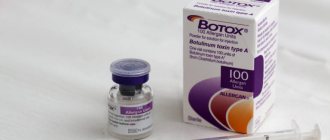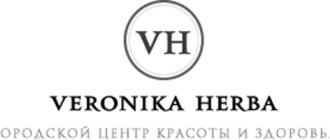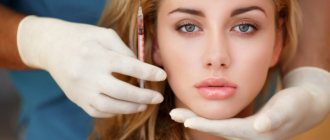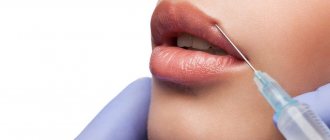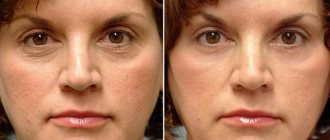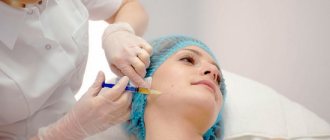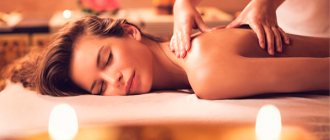Aesthetic medicine is still shrouded in mystery for many. So many “legends” have formed around beauty injections that are popular today that it is difficult to understand what is truth and what is fiction. It is believed that only stars can afford them, since procedures using them cost a lot of money. Today we will try to debunk the myths that have developed around beauty injections using the example of the innovative filler volumizer Radiesse.
WHAT ARE BEAUTY INJECTIONS FOR, HOW THEY WORK AND WHEN TO USE THEM
Injection cosmetology (popularly “beauty injections”) is a branch of aesthetic medicine and an integral part of modern methods of rejuvenation and prevention of aging.
The use of injection techniques is aimed at solving a variety of problems: smoothing wrinkles and folds, replenishing missing volumes and providing a lifting effect, correcting facial asymmetry, improving the quality and color of the skin, reducing pigmentation, pathological vascular network and the severity of acne, restoring the water-lipid mantle of the skin.
Of course, it is very difficult to understand the indications for injection procedures and at what age to carry them out, especially if you are still very young and it seems that it is too early to resort to such serious procedures. It is important to note that injections, like any cosmetic procedures in principle, should not be done in accordance with any age categories, but solely according to indications!
In the case of injection techniques, everything is too individual!!!
Indications for removing hyaluronic acid from lips
Indications for the removal of hyaluronic acid can include both the aesthetic desire of the patient to return the lips to their original appearance (due to asymmetry, hyper-effect, uneven contour), and complications that arose after lip correction:
- compactions and lumps at the injection site;
- swelling and redness;
- uneven distribution of material and deformation of the mouth;
- allergic reactions;
- hematomas;
- exacerbation of herpes;
- inflammatory process;
- tissue necrosis.
However, it is necessary to distinguish between complications after the administration of hyaluronic acid and the normal reaction of the body. Normally, inflammation and slight swelling that appear immediately after the correction completely disappear within 3 to 7 days.
Removal of hyaluronic acid (not introduced in our clinic)
Removal of unsuccessfully injected lip filler (not in our clinic)
Biorevitalization
The word itself comes from the Latin “bio” (life) and “revitalization” (restoration). In a general sense, biorevitalization includes all rejuvenation techniques that, through subcutaneous or intradermal administration of biologically active substances, improve the condition of the extracellular matrix.
These are preparations based either on hyaluronic acid alone , or its combination with vitamins, minerals, amino acids, plant extracts - in this case the method is usually called bioreparation.
The rehabilitation period after removing hyualuronic acid from the lips
At the end of the procedure, the patient is under the supervision of a specialist for an hour to eliminate the risks associated with the onset of anaphylactic shock. A few weeks later, a second visit to a specialist is scheduled for examination. If necessary, the enzyme can be reintroduced.
However, this method of removing hyaluronic acid is impossible if the patient has the following contraindications:
- pregnancy and breastfeeding;
- individual intolerance to the enzyme;
- fresh traces of hemorrhage in the area being corrected;
- risks of hypersensitivity to the enzyme;
- connective tissue diseases;
- exacerbation of chronic inflammatory processes;
- acute infectious diseases;
- oncology.
The effect of biorevitalization
The magic of hyaluronic acid lies in its ability to attract and retain water due to its large molecular weight. Its huge role in moisturizing the skin has already been scientifically proven. Thanks to this property, preparations based on “hyaluronic acid” saturate the skin with moisture, making it more protected from the effects of aggressive environmental factors and microorganisms, giving it elasticity and a healthy appearance.
In addition, bioremedies act on fibroblasts, activating intracellular processes, accelerating the production of collagen, elastin and its own hyaluronic acid.
EVENTUALLY:
The skin is evened out and its elasticity increases. The complexion improves, age spots and wrinkles become less noticeable or disappear altogether, and stretch marks are reduced.
When to start biorevitalization procedures
Injections of biorevitalizants are used for visible rejuvenation of the skin of the face, neck and décolleté, hands and any other parts of the body that the patient wants to “revive”.
This is one of the most effective methods for preventing photoaging and restoring the hydrolipid mantle of the skin after exposure to the sun or after a frosty winter, etc.
The very first manifestation of age-related changes is the loss of moisture in the skin. This process is associated both with the failure of protective barriers and with a physiological age-related decrease in the synthesis of hyaluronic acid. In the first stages, we can only cope with external means, depending on our genetic characteristics, but only up to the age of 30. Then, starting at the age of 35, the moment comes when we need to start “preventing” aging. Yes, that’s right: by starting to work with the skin on time and regularly – by “biorevitalizing” it at least 2 times a year – you can significantly slow down all age-related changes .
How long does the effect of biorevitalization last?
Hyaluronic acid deposited in the skin breaks down naturally and is excreted from the body, so the result after a course of procedures of three injections lasts on average 4-6 months. Moreover, this period depends not only on the drug, but also on the individual characteristics of the body and lifestyle - smoking, sun rays, ultrasonic waves, etc. accelerate the breakdown of hyaluronic acid. In addition, new generation drugs, for example, Profhilo biorevitalization, provide hydration for up to 6 months after a double procedure. The same technique can be used for the neck, décolleté and hands.
Botox injections
How they work
Botox under different brands - Dysport® (AbobotulinumtoxinA), Botox® (OnabotulinumtoxinA), Xeomin® (IncobotulinumtoxinA), RELATOX® (Botulinum toxin type A complexed with hemagglutinin) - contains purified and weakened botulinum toxin, which blocks the nerve signal and, as it were, freezes muscles. As a result, some wrinkles are softened or completely smoothed out.
The method is effective only for eliminating expression wrinkles, that is, those that form as a result of facial activity on the forehead, between the eyebrows, at the base of the nose and in the corners of the eyes. Such injections are not always able to remove wrinkles and folds caused by tissue sagging.
MYTH No. 3 Silicone and Botox on lips
They will give me a Botox beauty injection, and I will be like many show business stars: with pumped up silicone lips and a doll-like motionless face.
Silicone is almost never used today: it has been banned as a filler for several years in Europe and America. Regarding botulinum toxin, there are currently several drugs available. They vary in safety and outcome. The latest generation of such drugs smooths out wrinkles, but the face retains lively facial expressions and does not look “frozen.” And another misconception is that botulinum toxin preparations cannot be injected into the lips. It relaxes the muscles and they stop moving, so you can smooth out wrinkles on the forehead and around the eyes.
But to make your face look young, it is not enough to straighten a single wrinkle; you need to restore the volumes lost with age to your face. Radiesse is used for this.
How does mesotherapy work?
The active ingredients can be different: from vascular protectors and other registered drugs to vitamins, microelements, lipolytics and plant extracts, for example, artichoke extract. Often hyaluronic acid is also present in cosmetic meso-cocktails, but this is not a necessary component.
Hence the various effects and wide scope of application. Each component of the solution has a different effect on skin tissue. For example, during lipotherapy, lipolytics destroy the membrane of fat cells, accelerate lipolysis - the breakdown of fats - and even out the structure of the skin through collagen synthesis.
Indications and when to start doing mesotherapy
Due to the diversity of the composition of drugs, mesotherapy in cosmetology is used:
- to rejuvenate the skin and improve its quality;
- in the treatment of acne, correction of pigmentation, stabilization of the vascular wall;
- to combat alopecia;
- during lipomodelling, when you need to remove excess fat and shape the contours of the face and body;
- in the complex correction of stretch marks.
The dermatologist selects the dosage and drug or their combination, focusing on the problem. There are no ready-made solutions.
Starting from adulthood, if you have the above problems, you can start doing mesotherapy procedures.
Contour plastic surgery - injection of fillers
Contour plastic surgery is the introduction of drugs called fillers into the problem area. Fillers are ready-made fillers in the form of gels of varying degrees of viscosity, of natural or synthetic origin, which in many cases can replace surgical plastic surgery. At the same time, the techniques for introducing fillers into the skin can be very different: with a microneedle directly under the wrinkle, using a thin guide - a cannula, or the vector lifting technique.
When it helps
Thanks to skillful injections, you can tighten the oval of the face, hide nasolabial folds or remove bags under the eyes, restore the volume of the lips and correct their asymmetry, eliminate jowls, raise the corners of the eyebrows for a more expressive look, and lift the corners of the lips, which droop down with age. With the help of fillers, you can even correct the shape of the nose or chin, “remove” fine wrinkles in the cheek area and, in addition, significantly improve the quality of the skin.
It is important to understand that it is impossible to choose such a drug in absentia. They differ in composition, viscosity and concentration of hyaluronic acid, as well as the presence of other active ingredients. The dermatologist selects the right drug and the option for its administration based on many factors: the general condition of the skin, the severity and depth of wrinkles and their location, the anatomical structure of the face, age and tendency to allergies.
How does it work
As adipose tissue decreases, the skin loses elasticity and sags. Fillers fill these voids and folds, thus smoothing out wrinkles, strengthening and improving the tissue structure. The active composition varies:
- Hyaluronic acid. The safest filler, since a similar substance is produced in our body. Hyaluronic acid retains moisture and stimulates the production of your own collagen and elastin. Another plus is that the result is reversible. So asymmetry or too voluminous lips can be corrected: the doctor will simply inject hyaluronidase, which quickly breaks down the hyaluronic acid.
- Collagen. There are two varieties: synthetic and animal origin. The main advantage of this filler is that the face looks natural after such plastic surgery.
- Poly-L-lactic acid (preparation AestheFill ) is a biocompatible synthetic substance. The filler stimulates the synthesis of its own collagen, due to which a pronounced rejuvenating effect is manifested. The result is not noticeable immediately, but after a course of injections - after 2 months, with a gradual increase in the effect.
How long does the effect last?
Biodegradable fillers last the least. Thus, collagen of animal origin begins to disintegrate within a month and the result, accordingly, disappears.
Hyaluronic acid injections will have to be repeated after an average of 6–9 months. Fillers with poly-L-lactic acid - up to 12-14 months.
Fillers can go by a variety of names. However, it is not the brand that is more important, but understanding what kind of filler you need.
When to start doing
In relation to contour plastic surgery, this is a rhetorical question, since the goals, objectives and possibilities of the technique are quite wide: that is, according to the presence of aesthetic defects or as they appear, but not earlier than from the age of 18.
Side effects
In the hands of a professional, side effects from contour plastic surgery performed with high-quality certified drugs occur extremely rarely. In addition to an allergic reaction, which more often occurs with fillers of animal origin, hypercorrection syndrome may “manifest.” In this case, the drug Hyaluronidase is administered, an enzyme that dissolves hyaluronic acid.
MYTH #2 This is plastic surgery
Beauty injections are as serious as plastic surgery. Women do not realize that this is a real serious medical procedure with general anesthesia.
In fact, these are two completely different things. True, their results may be comparable. Volumizer Radiesse restores the volume of soft tissues of the face lost with age and returns youth to the face. It stimulates the skin's production of its own collagen: the face acquires a clearly defined oval, and the skin becomes elastic and tightened. Of course, Radiesse injections cannot replace plastic surgery, but they can delay its timing by 5 to 7 years. The Radiesse injection procedure will take no more than 40 minutes. The doctor injects the drug with a thin needle into the desired areas. It's practically painless. After the procedure, there may be some minor bruising and swelling, but this will go away within 5-7 days.
Plasma therapy
Plasma therapy is positioned as a natural healing of the skin and more. Instead of drugs, the patient’s own plasma is used here, processed in a special way and enriched with platelet-derived growth factors. Plasma therapy is also called plasma lifting or PRP therapy - all these are synonyms.
How does it work
Plasma enriched with growth factors helps remove cell components destroyed by photoaging, activates fibroblasts that produce collagen, improves and renews skin tissue.
Multiple studies confirm the results: smooth texture and tone of the face, less noticeable wrinkles and stretch marks, a slight lifting effect.
When it helps
In aesthetic medicine, plasma therapy is recommended to be used:
- for aging skin, as plasma lifting improves relief and color, relieves swelling, reduces wrinkles;
- in the treatment of acne and post-acne, atopic dermatitis and eczema;
- when restoring skin after aggressive procedures.
Plasma therapy is often used in combination with other techniques, such as fillers, chemical peels or laser procedures. This is how PRP helps the skin recover faster after procedures.
How long does the effect last?
According to scientific research, the results of PRP therapy appear faster and last longer in younger patients - up to 35 years. For such people, it is enough to repeat the injections after 12–24 months.
Side effects
If the conditions for plasma therapy are strictly observed (taking blood on an empty stomach, no exacerbations of herpes infection for a month, etc.), there is usually no adverse reaction.
Hyaluronic acid injections
Hyaluronic acid injections
If you choose the most popular cosmetic procedure, botulinum therapy will deservedly take first place, which allows you to successfully resist the signs of aging in the form of hyperkinetic wrinkles. Hyaluronic acid injections will take second place, but if you combine all the procedures that use this amazing organic compound, HA injections can compete with the famous Botox!
In this material we will consider the areas of application of hyaluronic acid in modern cosmetology. Let's talk about the procedures in which it is used, indications for its use, advantages, capabilities and disadvantages of existing techniques. Questions regarding recovery after the session and possible side effects will also be addressed.
Areas of use
Since hyaluronic acid injections are used very widely, it is appropriate to divide all indications for use into two large groups. The first includes anti-aging cosmetic procedures that are aimed at eliminating the signs of aging or preventing them. Secondly, plastic cosmetology procedures that change facial features and improve the patient’s appearance through targeted modeling of certain areas.
Anti-aging procedures: mechanism of action of HA
Popular anti-aging procedures with hyaluronic acid include biorevitalization, bioreparation, and mesotherapy. In European countries, biorevitalization is considered one of the areas of mesotherapy, but in domestic cosmetology it is separated into an independent procedure. As for bioreparation, it is considered one of the areas of biorevitalization.
But let’s not complicate the publication with subtle nuances regarding terminology and formulations; let’s dwell on the mechanism of action of hyaluronic acid. The secret to the effectiveness of this organic compound in rejuvenation programs is simple. Hyaluronic acid is a natural component of the dermis, which is responsible for its elastic properties, tone, moisture, turgor, and ability to withstand external influences.
In youth and adolescence, the skin is rich in hyaluronic acid. Fibroblasts, skin cells that synthesize elements that form the intercellular matrix, produce HA in sufficient quantities. The rate of synthesis of molecules is faster than the rate of their destruction, and therefore, as a rule, young girls do not have skin problems. At least those problems that are associated with age-related changes - wrinkles, deformation of the oval of the face, increased microrelief and decreased elasticity of the skin.
With age, the rate of formation of new HA molecules slows down, and the rate of degradation of this organic polymer, on the contrary, accelerates. The concentration of natural hyaluronic acid in the dermis decreases. A direct consequence of this is a deterioration in skin hydration, since one HA molecule holds about 500 water molecules. Not only moisture content decreases, but the elastic properties of the dermis, its elasticity and strength deteriorate.
Injections of hyaluronic acid help restore the original concentration of this polysaccharide in the middle layers of the dermis. Concentration typical for young and young adults. In cosmetology, HA of synthetic origin is used, obtained by bacterial synthesis and genetic engineering, but its properties are identical to natural hyaluronic acid.
Biorevitalization
In biorevitalization, the main component of the drug (biorevitalizant) is unstabilized HA. Immediately after the procedure, it saturates the facial skin with moisture and also has a stimulating effect on cellular elements. Under the influence of hyaluronic acid injections, the metabolic activity of fibroblasts increases. They begin to more actively synthesize molecules of elastin, collagen and other components of the intercellular matrix. The proliferative activity of stem cells increases, which leads to the replenishment of the cell pool with young fibroblasts, which, unlike old cells, are at the beginning of the life cycle.
In addition to hyaluronic acid, the biorevitalizant contains additional components. Which ones exactly depend on the type of drug. Many manufacturers include peptides, embryonic and platelet growth factors, vitamins, and amino acids. The complex of biologically active substances has a synergistic effect and doubles the rejuvenating effect of the procedure.
Mesotherapy
Mesotherapy courses use drugs with a slightly different composition. In addition to hyaluronic acid, they contain a large number of other components. Among others, meso-cocktails may include plant extracts, homeopathic remedies, microelements, peptide molecules, growth factors, biostimulants, antioxidants and vitamins.
Mesotherapy is used both in rejuvenation programs and to improve the condition of problem skin.
If we draw a conditional line between biorevitalization and mesotherapy, then the first technique is intended exclusively for rejuvenation, the second - for rejuvenation, prevention of aging, as well as for the correction of certain defects and various aesthetic problems not related to involutional processes. Make an appointment

